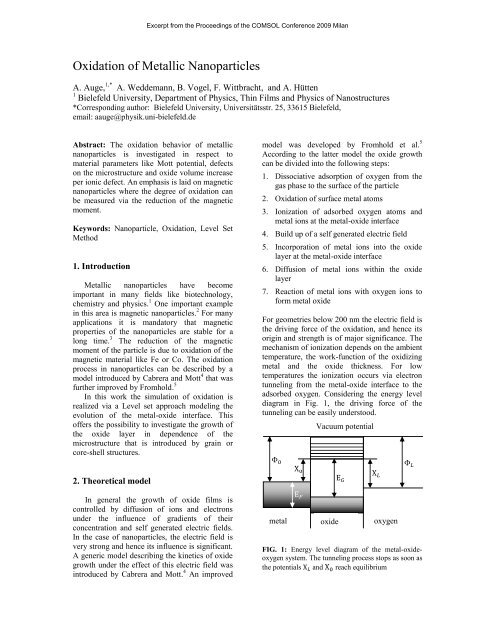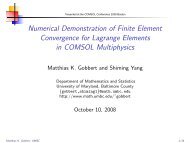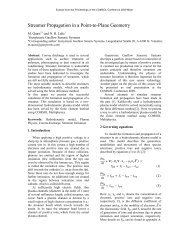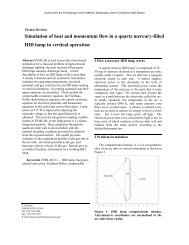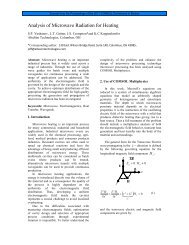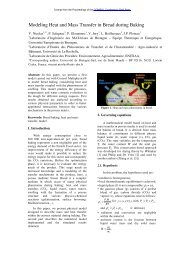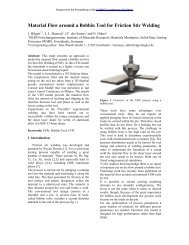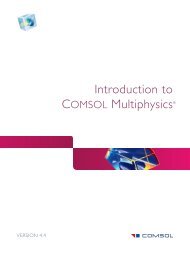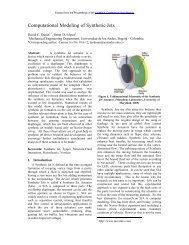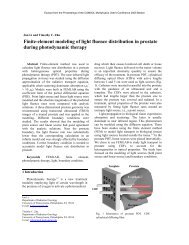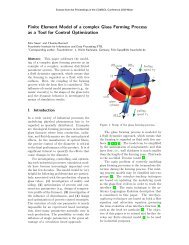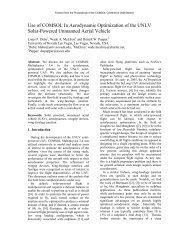Oxidation of Metallic Nanoparticles - COMSOL.com
Oxidation of Metallic Nanoparticles - COMSOL.com
Oxidation of Metallic Nanoparticles - COMSOL.com
- No tags were found...
You also want an ePaper? Increase the reach of your titles
YUMPU automatically turns print PDFs into web optimized ePapers that Google loves.
Excerpt from the Proceedings <strong>of</strong> the <strong>COMSOL</strong> Conference 2009 Milan<strong>Oxidation</strong> <strong>of</strong> <strong>Metallic</strong> <strong>Nanoparticles</strong>A. Auge, 1,* A. Weddemann, B. Vogel, F. Wittbracht, and A. Hütten1 Bielefeld University, Department <strong>of</strong> Physics, Thin Films and Physics <strong>of</strong> Nanostructures*Corresponding author: Bielefeld University, Universitätsstr. 25, 33615 Bielefeld,email: aauge@physik.uni-bielefeld.deAbstract: The oxidation behavior <strong>of</strong> metallicnanoparticles is investigated in respect tomaterial parameters like Mott potential, defectson the microstructure and oxide volume increaseper ionic defect. An emphasis is laid on magneticnanoparticles where the degree <strong>of</strong> oxidation canbe measured via the reduction <strong>of</strong> the magneticmoment.Keywords: Nanoparticle, <strong>Oxidation</strong>, Level SetMethod1. Introduction<strong>Metallic</strong> nanoparticles have be<strong>com</strong>eimportant in many fields like biotechnology,chemistry and physics. 1 One important examplein this area is magnetic nanoparticles. 2 For manyapplications it is mandatory that magneticproperties <strong>of</strong> the nanoparticles are stable for along time. 3 The reduction <strong>of</strong> the magneticmoment <strong>of</strong> the particle is due to oxidation <strong>of</strong> themagnetic material like Fe or Co. The oxidationprocess in nanoparticles can be described by amodel introduced by Cabrera and Mott 4 that wasfurther improved by Fromhold. 5In this work the simulation <strong>of</strong> oxidation isrealized via a Level set approach modeling theevolution <strong>of</strong> the metal-oxide interface. This<strong>of</strong>fers the possibility to investigate the growth <strong>of</strong>the oxide layer in dependence <strong>of</strong> themicrostructure that is introduced by grain orcore-shell structures.model was developed by Fromhold et al. 5According to the latter model the oxide growthcan be divided into the following steps:1. Dissociative adsorption <strong>of</strong> oxygen from thegas phase to the surface <strong>of</strong> the particle2. <strong>Oxidation</strong> <strong>of</strong> surface metal atoms3. Ionization <strong>of</strong> adsorbed oxygen atoms andmetal ions at the metal-oxide interface4. Build up <strong>of</strong> a self generated electric field5. Incorporation <strong>of</strong> metal ions into the oxidelayer at the metal-oxide interface6. Diffusion <strong>of</strong> metal ions within the oxidelayer7. Reaction <strong>of</strong> metal ions with oxygen ions t<strong>of</strong>orm metal oxideFor geometries below 200 nm the electric field isthe driving force <strong>of</strong> the oxidation, and hence itsorigin and strength is <strong>of</strong> major significance. Themechanism <strong>of</strong> ionization depends on the ambienttemperature, the work-function <strong>of</strong> the oxidizingmetal and the oxide thickness. For lowtemperatures the ionization occurs via electrontunneling from the metal-oxide interface to theadsorbed oxygen. Considering the energy leveldiagram in Fig. 1, the driving force <strong>of</strong> thetunneling can be easily understood.Vacuum potential2. Theoretical modelIn general the growth <strong>of</strong> oxide films iscontrolled by diffusion <strong>of</strong> ions and electronsunder the influence <strong>of</strong> gradients <strong>of</strong> theirconcentration and self generated electric fields.In the case <strong>of</strong> nanoparticles, the electric field isvery strong and hence its influence is significant.A generic model describing the kinetics <strong>of</strong> oxidegrowth under the effect <strong>of</strong> this electric field wasintroduced by Cabrera and Mott. 4 An improvedmetal oxide oxygenFIG. 1: Energy level diagram <strong>of</strong> the metal-oxideoxygensystem. The tunneling process stops as soon asthe potentials and reach equilibrium
Tunneling occurs due to the potentialdifference <strong>of</strong> the metal and the oxygenuntil the electric field <strong>of</strong> the ions is as strongas the potential difference(1)where the so called Mott potential and L theoxide thickness. For higher temperatures thermalemission <strong>of</strong> electrons is also important whichhowever is not considered here. The tunnelcurrent is given by the following expression 5 (2)with the Planck constant and the electronmass. The ionic diffusion current in the absence<strong>of</strong> space charge effects is given in the steadystate approximation by 5 (3)FIG. 2 Nanoparticle with different oxide volumeincrease rates. Grains are colored in orange. The shelland core are shown as red and blue regions,respectively.where denotes the oxide volume increase pertransported ionic defect.3. Simulation modelThe parameters and are the bulkdefect concentrations <strong>of</strong> the diffusing ionicspecies at the oxide-oxygen and at the metaloxide interface, respectively. is the surfacecharge field in the oxide, the elementarycharge, the effective charge <strong>of</strong> thetransported ionic species, a the lattice constant, kthe Boltzmann constant, the temperature andthe thermal activation energy for ionicmotion. The assumption that the steady statecurrents are equal in magnitude but opposite insign leads to the following equation 5 (4)For this simulation model the nanoparticle isapproximated by a sphere <strong>of</strong> radius R and oxidelayer thickness L. The growth <strong>of</strong> the oxide layeris implemented via a Level set approach. 7 Thismethod is capable <strong>of</strong> describing the motion <strong>of</strong>surfaces and <strong>of</strong>ten used in multiphase flows.Here it is used to track the motion <strong>of</strong> the metaloxideinterface.The basic idea <strong>of</strong> the Level set method is toexpress a surface in an implicit form, as the zerolevel set or isophote <strong>of</strong> a higher dimensionalfunction and then trace the deformation <strong>of</strong>the surface by means <strong>of</strong> deformation <strong>of</strong> thisembedding function. Generally, for a givendomain with smooth boundary, we assume theexistence <strong>of</strong> an implicit function whichsatisfiesThis condition is used to determine the selfgenerated electric field in the oxide layer. Thegrowth <strong>of</strong> the oxide layer is then given by 5 (5)
FIG. 3: Comparison between experimental data forthe oxidation <strong>of</strong> Co nanoparticles withand simulation results for different values <strong>of</strong>the Mott potential. All other parameters are given inTab.1.The dynamic evolution <strong>of</strong> the Level setfunction follows the convection diffusionequation(5)where the normal velocity <strong>of</strong> the movingboundary and D is the diffusion coefficient. Inthe investigated systems diffusion is onlyintroduced to maintain numerical stability.Equation (5) defines the motion <strong>of</strong> the zero levelset . As an initial condition, we set(6)This is a signed distance function, andtherefore, has the advantage thatfor most <strong>of</strong> the domain except at the centerwhere certain partial derivates are not defined.The normal vector <strong>of</strong> the implicit surface iscalculated via . The growth <strong>of</strong> the oxidelayer and thus the normal velocity is given byequation (5). It is implemented in the followingway(7)The ionic current is determined for each timestep using equation (4). For this the distance Lhas to be calculated which is done via linearregression.(8)FIG. 4: <strong>Oxidation</strong> in dependence <strong>of</strong> temperature <strong>of</strong> ananoparticle with R = 5 nm and an initial oxide layer<strong>of</strong> 1nm. All other parameters are given in Tab. 1.It is also possible to implement further detailslike structural defects, grain structures or coreshell nanoparticles by varying the oxide volumeby an increase <strong>of</strong> on the nanoparticle domain.This is shown in Fig. 2. In this example the shellhas a high oxide volume increase per ionicdefect. Grains within the material are presentedas orange subdomains inside the core.4. Simulation resultsTo verify the simulation model, experimentaldata are <strong>com</strong>pared to calculated oxidation curves.For all simulations an initial oxide thickness <strong>of</strong> 1nm is assumed. The oxidation degree givenneglects this initial oxidation. This coincideswith experimental conditions, where themeasurements start after a certain oxidation time.In Fig. 3 experimental data <strong>of</strong> Co nanoparticleswith a mean radius <strong>of</strong>andsimulation results are shown. The nanoparticlesoxidized at room temperature and the loss <strong>of</strong>magnetization is measured via an AlternatingGradient Magnetometer. To calculate the loss <strong>of</strong>magnetization the degree <strong>of</strong> oxidation is used.The simulation fits well to the experimental dataif a Mott potential <strong>of</strong>and remaining parameters according to Tab. 1are chosen.Furthermore, the oxidation <strong>of</strong> nanoparticlesin dependence <strong>of</strong> temperature and the oxygenwork function are investigated. In Fig. 4oxidation curves for different temperatures isshown. All curves show a rapid increase <strong>of</strong>oxidation followed by a slow linear increase. For
FIG. 5: <strong>Oxidation</strong> in dependence <strong>of</strong> the oxide workfunction <strong>of</strong> a nanoparticle with R = 5nm and an initialoxide layer <strong>of</strong> 1 nm. All other parameters are given inTab. 1.rising temperature, the initial fast oxidationincreases rapidly. The slow increase is alsoaffected by a change <strong>of</strong> slope. The change <strong>of</strong> theoxidation rate is due to the increase <strong>of</strong> the ioniccurrent, which is exponentially affected by thetemperature.In Fig. 5 the oxidation in dependence <strong>of</strong> theoxygen work function is shown. Forthe initial fast oxidation is visible. Forthe growth shows a linearbehavior. This can be attributed to growthkinetics limited by the electron current. In Fig. 6the effect <strong>of</strong> different growth regions, which ispossible with the Level set method, is shown.Deformations <strong>of</strong> the metal-oxide interface arevisible where the growth rate is enhanced.5. Summary and OutlookIn this work a Level set based method isintroduced to model the oxidation dynamics <strong>of</strong>metallic nanoparticles. A <strong>com</strong>parison betweenexperimental data from the oxidation <strong>of</strong> Conanoparticles shows good agreement with thesimulations. It has also been shown, that it ispossible with the proposed approach to modeldifferent regions <strong>of</strong> growth within thenanoparticle. For the future, further studies onthe influence <strong>of</strong> the latter are planned.FIG. 6: Regions with different growths rates <strong>of</strong>nanoparticle as well as an oxide-metal interface (greenlayer) are shown. A distortion <strong>of</strong> the interface isvisible at the areas with increased oxide growth rate.6. AppendixSymbol Definition ValueMetal oxide work function 2(eV)work function (eV) 2.5Mott potential (eV) -0.5T Temperature (K) 3002a Ionic jump distance 4.25Ionic defect concentration atmetal oxide interface (Ionic defect concentration atoxide oxygen interface (Oxide volume increase pertransported ionic defectTable 1: Parameters used for simulationsReferences19.191 J. Blackman, <strong>Metallic</strong> <strong>Nanoparticles</strong>, Elsevier (2009)2 S. P. Gubin, Magnetic <strong>Nanoparticles</strong>, Wiley-VCH(2009)3 G. A. Niklasson, R. Karmhag, Surface Science 532–535, 324–327 (2003)4 N. Cabrera et al., Rept. Progr.Phys. 12, 163 (1949)5 A. T. Fromhold, E.A. Cook, Phys. Rev. 158, 600–612 (1967)6 S. Osher, R. Fedkiw, Level Set Methods and DynamicImplicit Surfaces, Springer (2002)


